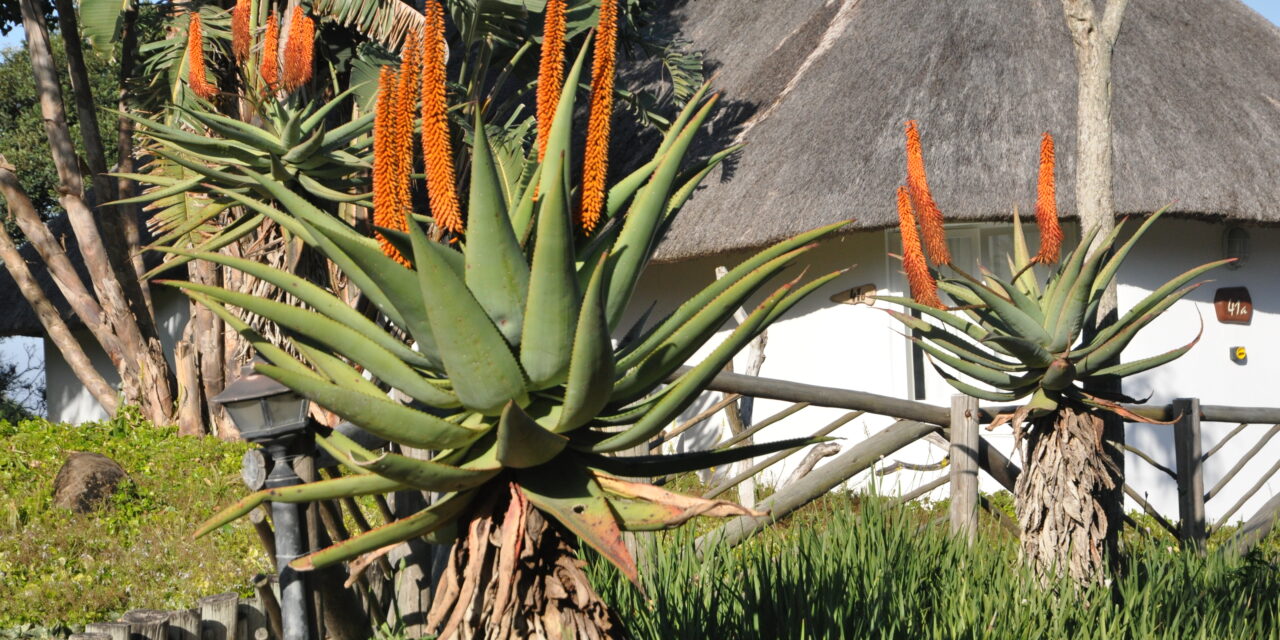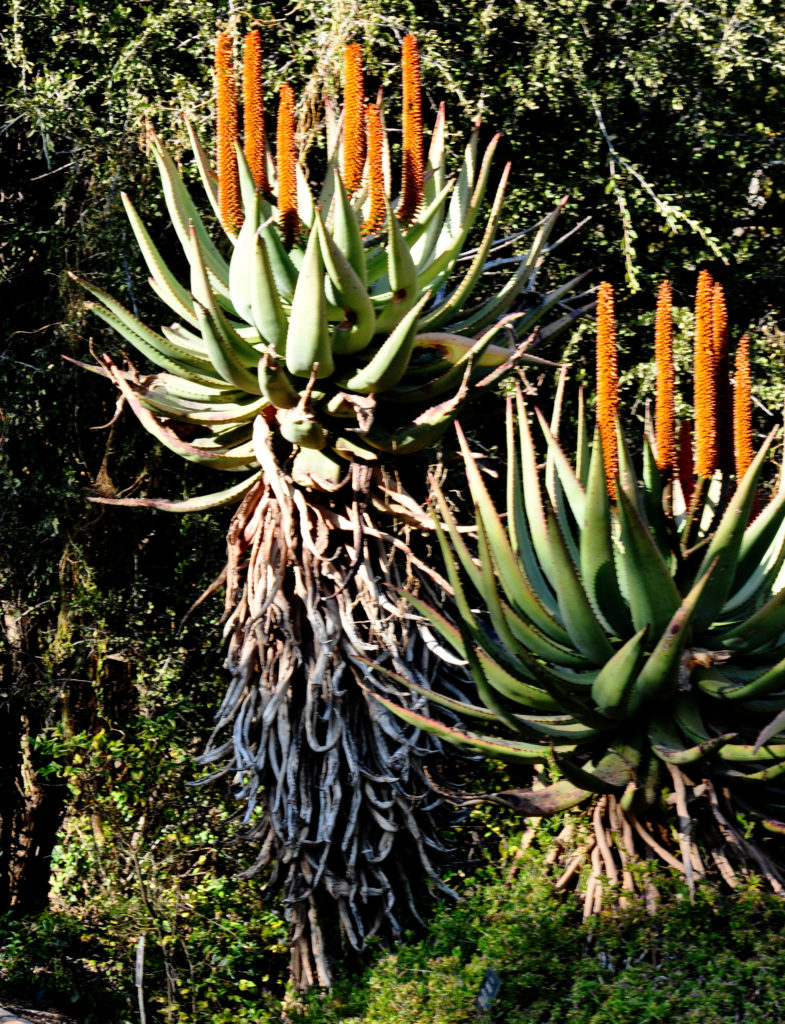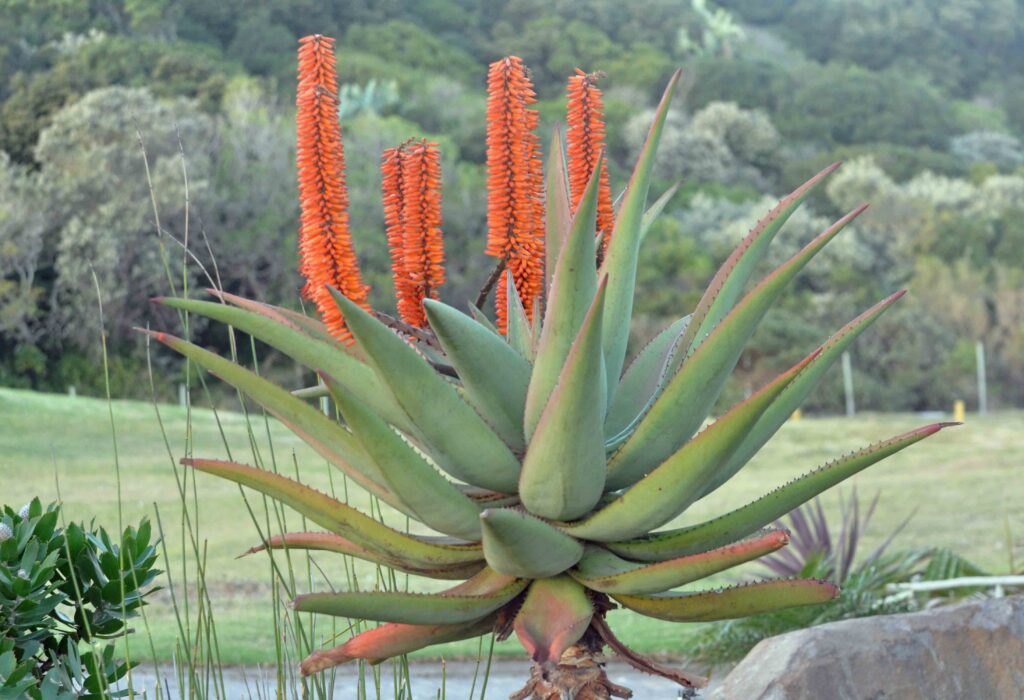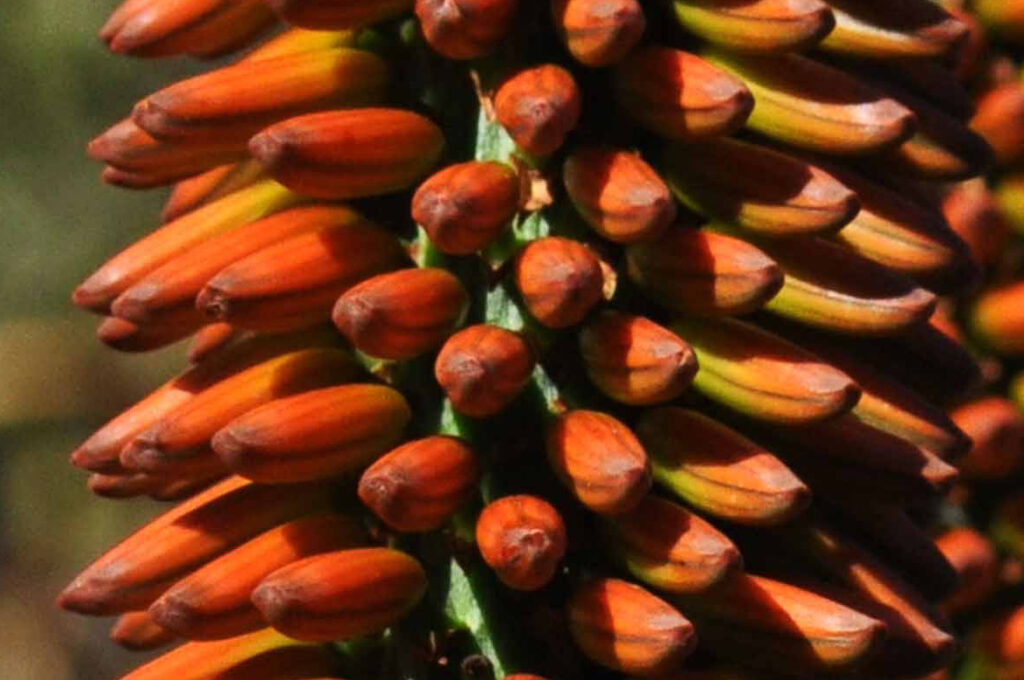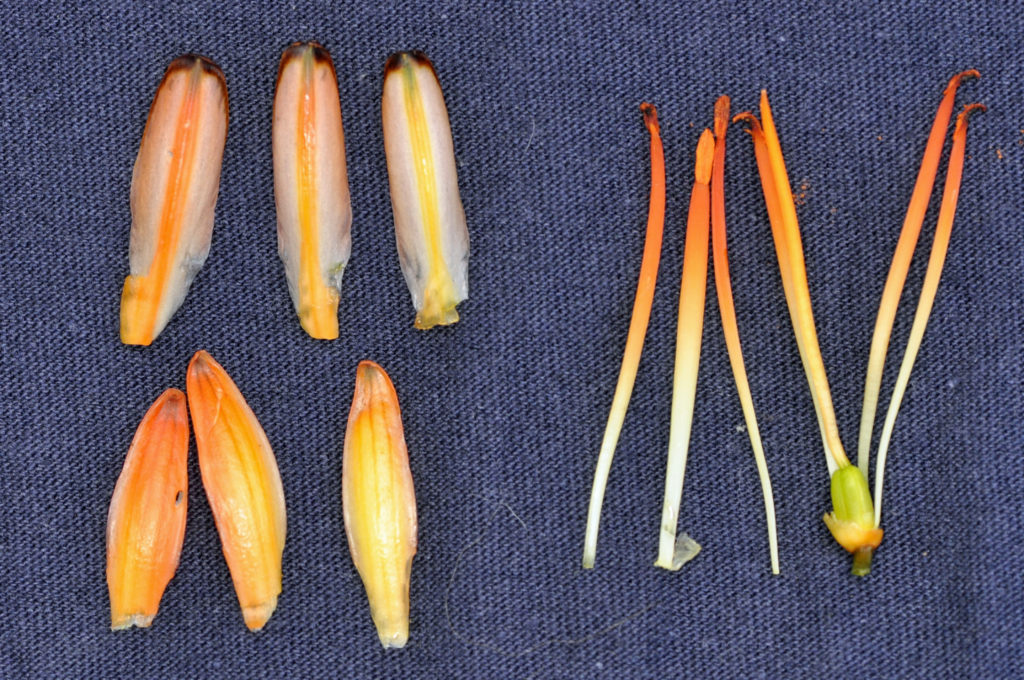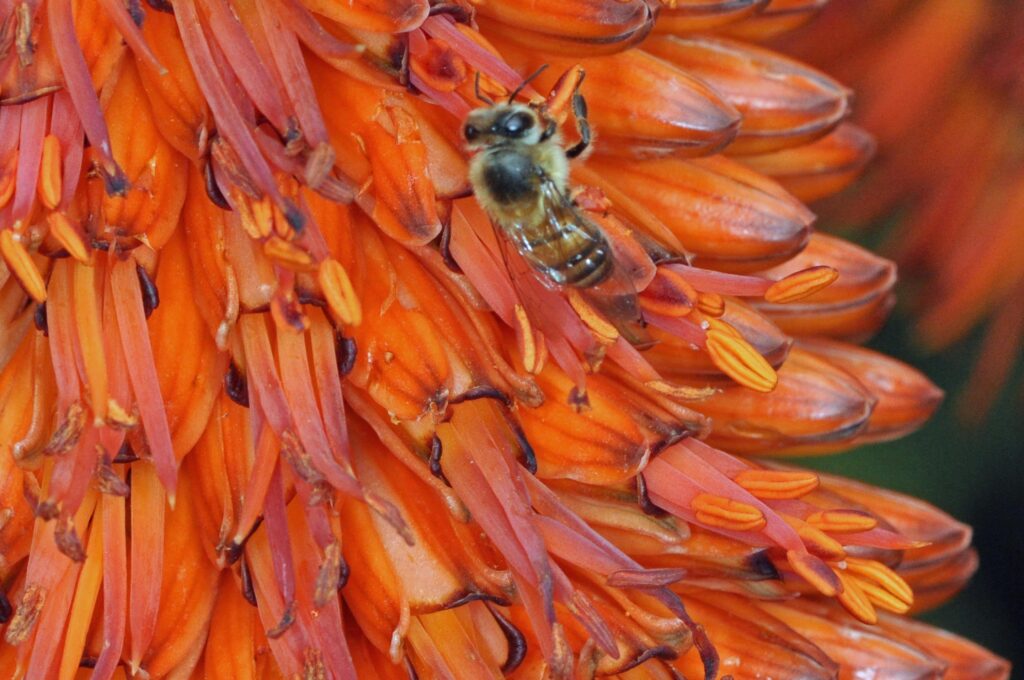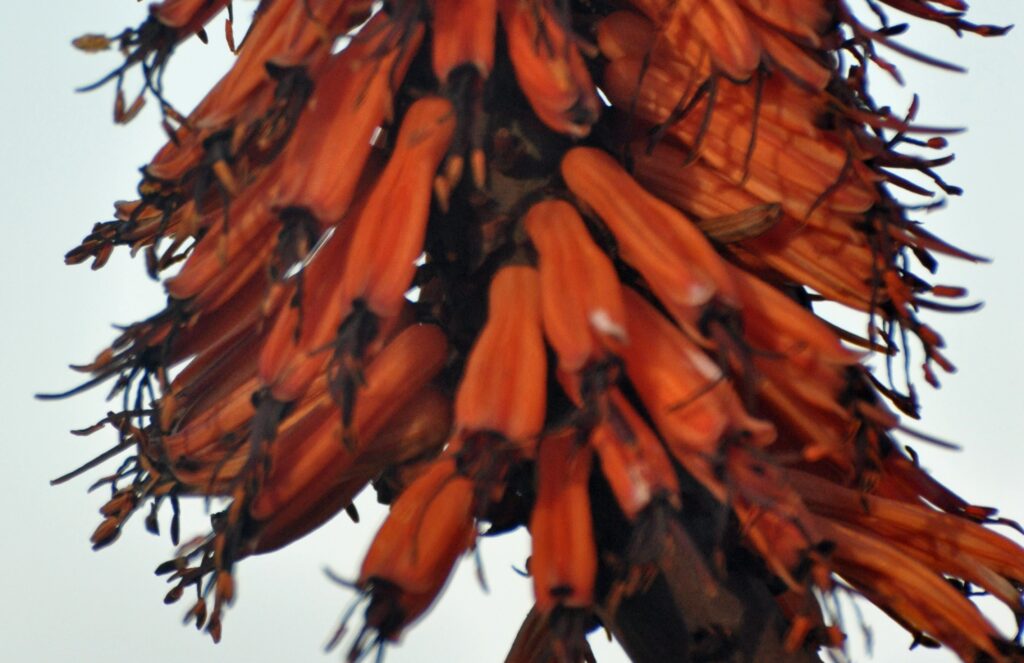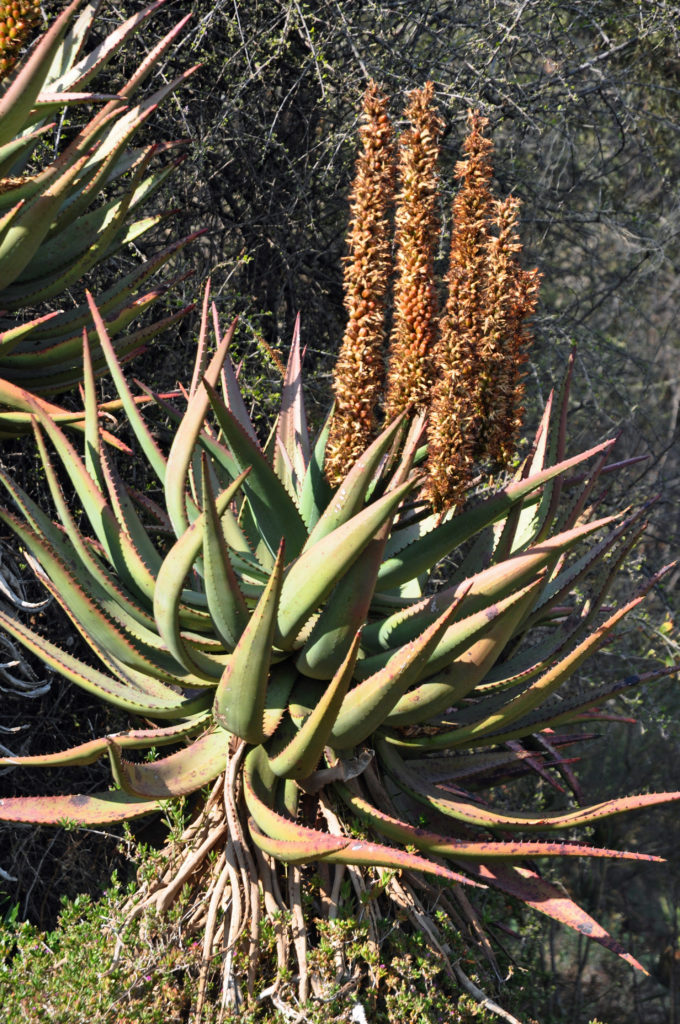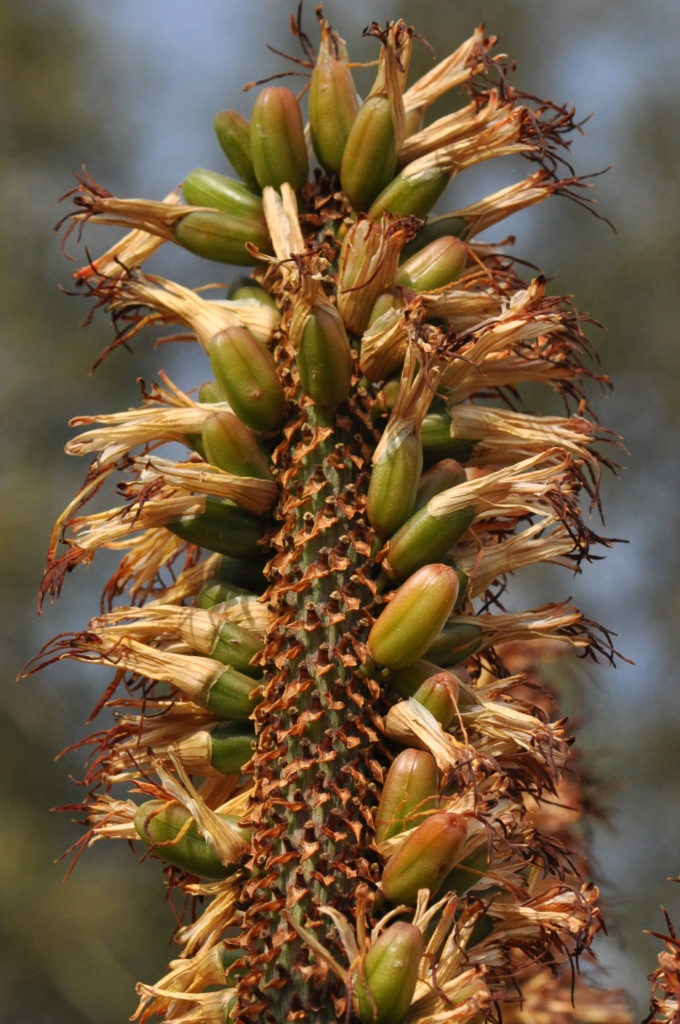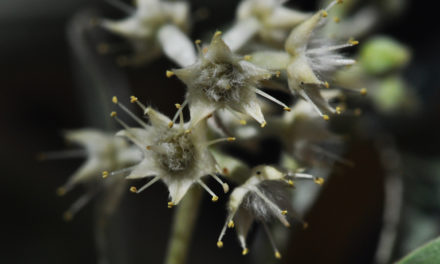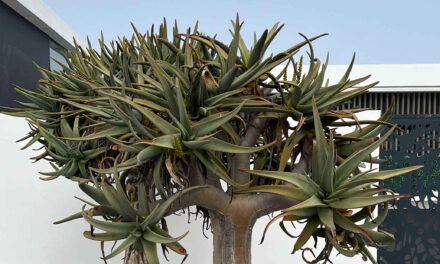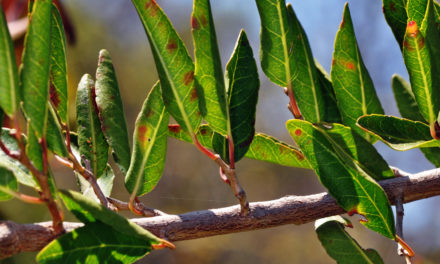Aloe ferox
General Info – summary
This adaptable Tree trunk is up to 5m high. Succulent Leaves have an amplexicaul base and spines occur on margins and possibly the blade. Shrunken old leaves remain. Regular Flowers are in up to 12 erect racemes. 6 tepals occur outside the 6 exserted stamens. The pistil has a superior ovary and a single exserted style. Fruit: a trilocular apically truncated capsule with irregularly angled & slightly winged seeds.
This adaptable Tree trunk is up to 5m high. Succulent Leaves have an amplexicaul base, & spines occur on margins and possibly the blade. Shrunken old leaves don’t fall. Regular Flowers are in up to 12 erect racemes. The 6 tepals surround the 6 exserted stamens. The pistil has a superior ovary & a single exserted style. Fruit: a trilocular, apically truncated capsule with irregularly angled & slightly winged seeds.
Description
Previous Names: Aloe ferox. var. galpinii, Aloe ferox. var. incurva, Aloe galpinii, Aloe perfoliata. var. epsilon, Aloe perfoliata. var. gamma, Aloe perfoliata var. theta, Aloe perfoliata var. zeta, Aloe perfoliata, Aloe pseudo-ferox, Aloe subferox, Aloe supralaevis, Aloe supralaevis var. erythrocarpa, Pachidendron ferox, Pachidendron pseudo-ferox, Pachidendron supralaeve.
SA Tree No. 29.2.
Common names: (Afr) Aalwyn, Bergaalwee, Bergaalwyn, Bitteraalwyn, Kanniedood, Kraalalwee, Kraalalwyn, Makaalwyn, Makalwee, Opregte Aalwyn, Regte Aalwee, Regte Aalwyn, Swellendam-aalwyn, Swellendamsaalwee, Tapaalwyn, Tapalwee, Tap-aalwyn, Tapalwyn. (Eng) Bitter Aloe, Cultivated Aloe, Red Aloe, Tap Aloe, Uganda Aloes. (isiXhosa) Ikhala. (isiZulu), Inhlaba, Umhlaba. (Setswana) Umhlaba.
Family Asphodelaceae (Aloe Family). Presumably derived from Asphodel Meadows, which is a section of the Ancient Greek underworld where indifferent and ordinary souls were sent to live after death. The family has about 40 genera and 900 species. There are 10 genera in South Africa. This is a small but wide-spread, mainly African family of perennial plants. All have Anthraquinones (an aromatic, organic compound, which are the main active constituents of herbs – often used to relieve constipation and may possess antifungal and antiviral activities. They are also widely used in dyes). When present, the Stems are fibrous and woody. The fleshy Leaves often have spines either on the margins or on the blades. The outer 2 flower whorls (the Perianth) lack the classic distinction between calyx and corolla and the lobes are called Tepals. These 2 whorls each have 3 tepals. Flowers are usually borne on a leafless stalk arising from the rosette of leaves. Individual flowers are regular. The 6 Stamens are inserted in 2 whorls of 3, below the superior 3 locular Ovary. Fruit is usually a dry Capsule. Genera with trees on this website include Aloe, Aloidendron and Kumara.
Name derivation: Aloe – dried juice from aloe leaves (Greek origin). ferox – ferocious: referring to the spiny leaves. There are about 500 species within the Aloe genus and at least 150 are indigenous in South Africa.
Conservation: National Status: L C. Least Concern. Assessed: 2018 (D. Raimondo, J.H. Vlok, B.E. van Wyk, E.J. van Jaarsveld and H. Mtshali). However, leaf-harvesting exploitation may need attention in the future.
Tree
This succulent, perennial, single stemmed Tree is unbranched and may reach 5m high. The thickset, usually singular Stem/trunk is the main axis of the plant. In Aloe ferox the plant stem becomes densely bearded with shrunken, down hanging, old dry leaves that remain on the tree (photo 73).
- 73. 2016/06/21. Walter Sisulu NBG. Photo: David Becking.
Leaves
Each thick, succulent, fleshy and strongly upward pointing Leaf is up to 1m long and 16cm wide with an amplexicaul base (a large leaf base that embraces a stem). Leaves are dull green and occur at the end of the stem in dense rosettes (leaf arrangement radiating, in this instance, from a crown – photo 432). Short, reddish, stout and almost equally spaced Spines may appear on the Margin (photo 80) and here they may be dentate (with sharp, spreading, rather coarse teeth that that protrude away from the margin). They start of at right angles to the margin and may have the end pointing slightly toward the leaf apex (photo 80). Spines may occur on both sides of the Blade (similar to Aloe marlothii). The broad Base of each leaf is decurrent (extends down and is attached to the trunk). The leaf gradually decreases in width ending with an acuminate apex (said of an acute Apex whose sides are somewhat concave and taper to a protracted point (photo 432). In this photo the young leaves point upwards. The slightly recurved mature leaves are bluish green and often tinged with yellow or red (photo 432). Unlike Aloidendron barberae (was Aloe barberae), the old grey, dried and shrunken leaves remain hanging down and extend more than halfway down the tall, usually single trunk (photo 73 under Tree).
- 432. 2016/07/08 East London. Photo: David Becking.
- 80. 2016/06/20 Walter Sisulu NBG. Photo: David Becking.
Flowers
The orange (photo 432 – under Leaves), scarlet, golden orange or red (photo 76) and, less commonly, white tubular Flowers are produced in a single branched Inflorescence (containing up to 12 erect, relatively wide, cylindrical Racemes (a simple, unbranched, indeterminate inflorescence with pedicellate – stalked flowers – along the axis that open in succession towards the apex). Each erect raceme is up to 0,9m high and stands above the leaves. The flowers are relatively wide and cylindrical. Each uncurved flower has one pedicel (stalk of a single flower – photo 640). The straight flowers are densely packed (photo 432 under Leaves). The smallish individual flowers are straight. Distinguishing between sepals and petals is often difficult and they are collectively called Tepals. The 6 tepals are in 2 rows of 3 each, in what is collectively called the Perianth. The apices of the inner 3 tepals are brown, black (photo 640) or white. The outer whorl of 3 tepals is usually darker (photo 640).
The 6 yellow/orange Stamens (male reproductive part of a flower) are in two whorls of 3 each (photo 640). They are longer than the tepals and project well beyond the perianth lobes (photo 421Z & 637A). On photo 637A, the relatively young stamens have clearly visible yellowish Anthers. The orange/purplish filaments support them (photo 640). Within the 6 stamens is a single Pistil (a unit of the Gynoecium, the female element of the flower, composed of the Ovary, Style and Stigma – photo 640). The superior Ovary is trilocular (with 3 compartments) and there is a single filiform (thread or filament like) Style (extending from the apex of the ovary (phot0 640: 3rd from the right). The tiny terminal Stigma is capitate (formed like a head) and well exserted (photo 421Z). Flowering near the Cape and close to the coast occurs from May – June, whereas in cooler inland areas it usually occurs from Jul-Sep). Plants on the warmer north facing slopes tend to open first.
- 76. 2016/06/21. Walter Sisulu NBG. Photo: David Becking.
- 640. 2017/08/01. Walter Sisulu NBG. Photo: David Becking.
- 637A 2017/08/01 Walter Sisulu NBG. Photo: David Becking.
- 421Z 2016.07.08 East London. Photo: David Becking.
Fruit
After pollination, the Tepals shrink and eventually fall (photo 1186), exposing the old stamens and developing ovaries (photo 497). As the Capsule (a dry fruit resulting from the maturing of a compound ovary, which usually opens at maturity by one or more lines of dehiscence) develops, the stamens also fall. The Fruit is a 3-segmented Capsule. This capsule is apically truncated (appearing as if cut off at the end – photo 497). The irregularly angled and laterally compressed Seeds are obscurely winged.
- 1186 2015/08/18 Walter Sisulu NBG. Photo: David Becking.
- 497 2016.08.16 Walter Sisulu NBG. Photo: David Becking.
Distribution & Ecology
This aloe is Endemic (Endemism is the ecological state of a species being unique to a defined geographic location). It is naturally widely distributed only in southern Africa – including fynbos (this is a belt of natural shrubland – dense thickets of evergreen shrubs and small trees in the winter rainfall area within the distinctive vegetation of the Western Cape). They also occur on rocky hillsides, coastal bush and grassland in the Western Cape, Eastern Cape (intro photo), southeast Free State, southern KwaZulu-Natal and southern Lesotho – from sea level to moderate altitudes (usually less than 700m). When flowering they are most dramatic in open spaces e.g., in the Karoo. Rainfall requirements are from 200 to 750mm pa. These trees survive temperatures from between -5 (including low frost) and up to 45 degrees C. This aloe is a Pioneer species in over utilised soils. Animals eat leaves in dry times. The Flowers are rich in nectar (10 flowers produce up to 1 cubic cm), and this attracts Birds including sunbirds, black-headed oriole (Oriolus larvatus), weavers, starlings and long tailed, speckled mousebirds (Colius striatus). This bird is common from the Cape to Eritrea. White-eyes and other birds, with shorter beaks, cannot reach the nectar directly and reach it by burrowing through the base of the flowers. The nectar also attracts monkeys and baboons as well as insects. These insects attract more birds. The multi-branched flower structure, much shorter racemes and the much further north location of Aloe excelsa. emphasises the difference from Aloe ferox.
Ethnobotany
Bushman paintings in caves were the first known illustrations of any aloe. Children seek after the Flower Nectar. If consumed in large quantities, it may cause partial paralysis. Sap from the Leaves is harvested commercially to fight acne, help prevent burn scars and for soothing itchy rashes. The consumed drug contains Alion, which overcomes constipation. Alion is no longer allowed to be sold in the USA (2002) – until further research is done. Aloe gel, without aloin, appears not to be a problem. Leaves have been used to make an excellent jam. The leaves have an important commercial value as a local medicinal plant. In times of need, farmers feed leaves to their cattle. Shrunken, dry old leaves are good fire starters – burning for a short time with an intense heat. Burning the old leaves also acts as an insect repellent. Crushed dry leaves are used to make snuff. As early as 1700, this aloe was planted in European gardens. Hybrids do occur – including between this plant and Aloe arborescens.
References
Boon, R. 2010. Pooley’s Trees of eastern South Africa. Flora and Fauna Publications Trust, Durban.
Coates Palgrave, M. 2002. Keith Coates Palgrave Trees of Southern Africa, edn 3. Struik, Cape Town.
Ginn, P.J. McIlleron, W.G. Milstein, S. 1989. The Complete Book of Southern African Birds. Struik Publishers (PTY) LTD. Third impression 1991.
Lawrence, G. H. M, 1951. Taxonomy of Vascular Plants, The Macmillan Company, New York. Tenth Printing 1965.
Palmer, E. & Pitman, N. 1972. Trees of southern Africa, Balkema, Amsterdam, Cape Town.
Raimondo, D., Vlok, J.H., van Wyk, B.E., van Jaarsveld, E.J. & Mtshali, H. 2018. Aloe ferox Mill. National Assessment: Red List of South African Plants version. Accessed on 2024/05/17.
van Wyk, B. & van Wyk, P. 1997 Field guide to Trees of Southern Africa, Struik, Cape Town.
https://en.wikipedia.org/wiki/Aloe_ferox
http://operationwildflower.org.za/index.php?option=com_content&view=article&id=107:aloe-ferox&catid=19&Itemid=29
http://www.plantzafrica.com/plantab/aloeferox.htm
https://en.wikipedia.org/wiki/Aloin

